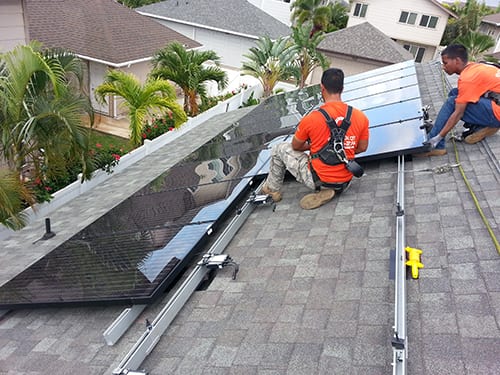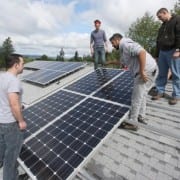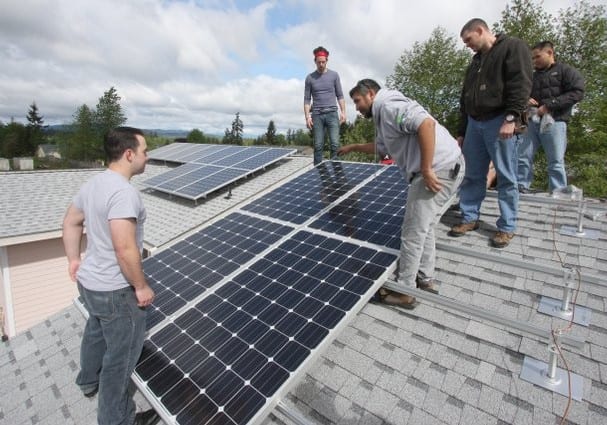APsystems looks ahead after a record 2020

New APsystems dual microinverter, the DS3
Despite the impact of the Covid-19 pandemic on the solar industry and the global economy overall, 2020 was a banner year for APsystems, which continues to advance its leadership in multi-module microinverter solutions.
The international company celebrated its 10th anniversary, surpassed 1 GW in microinverter shipments, marked a one-day delivery milestone, and further strengthened its relationships with partner companies, particularly in the emerging Latin American (LATAM) market.
The beginning
APsystems was founded in Silicon Valley in 2010 and has become a global leader in the development, manufacturing, and marketing of module-level power electronics (MLPE) products based on its solar technology.
The company’s co-founders, President and CEO Dr. Zhi-Min Ling and Chief Technology Officer Dr. Yuhao Luo, both have experience in the semiconductor and photovoltaics industries, having served in leading roles at Xilinx and Solaria Corp.
Within about two years, APsystems launched its first single and duo microinverter products. Later, the company launched the YC1000, the first native three-phase quad microinverter, then the dual microinverter YC600 with RPC function, and the QS1 microinverter.
In 2016, Olivier Jacques joined APsystems as vice president. With experience across many high-tech industries, including executive-level positions at Enphase Energy and Samsung Electronics, Jacques played an important role in increasing revenues, developing sales channels, launching a new product platform, and repositioning the company as a value-added solutions provider.

Alvin Xianyu, APsystems LATAM director
Today, APsystems has grown to encompass several global subsidiaries with warehouses, sales, marketing, and technical support teams around the world, including LatAm, Europe, North America, and Asia-Pacific, serving customers in more than 120 countries.
Main products include both AC-side microinverters and DC-side rapid shutdown devices for residential and commercial solar installations. The company’s EMA energy monitoring and analysis software also provides customer control over each individual module and microinverter in a solar array.
Alvin Xianyu, LATAM director of APsystems, called the company’s 10-year anniversary a “major landmark,” especially in the evolving inverter industry. “It has been a long and exciting journey,” said Xianyu. “The path we’ve taken to get here has been incredibly fulfilling and has brought a strong sense of accomplishment.”
The company has also been profitable each of the past nine years.
“Staying alive is one thing,” said Xianyu, “but growing profitably when you need to heavily invest in R&D on one side, while keeping enough agility to adapt to an ever-changing emerging market on the other side, is another challenge.”
He added that APsystems’ success is primarily due to the “hard work, determination, and patience of the hundreds of talented and committed people who have joined and believed in this company over the years.”
The milestones
By the end of 2020, APsystems’ global cumulative microinverter shipments surpassed 1 GW, representing more than 3.5 million individual units. They are expected to generate a total 1.24 billion kWh annually and reduce carbon dioxide output by 910,000 tons, equal to the environmental benefits of 45 million trees.
When the impacts of Covid-19 started in early 2020, APsystems adjusted its production and business strategy in a timely manner and achieved growth in several main markets, including the United States, Europe, and LatAm.
APsystems plans to keep concentrating on product and market development. In fact, the company’s next goal is to achieve 1 GW of microinverter shipments annually.
It also reached a one-day delivery milestone last year: On Dec. 1, 2020, the company shipped 22,000 microinverter units totaling over 27 MW. Xianyu said the units were mostly quad microinverters, which offer distributors and installers increased reliability and lower MLPE system costs.
He added the delivery represented a record-setting moment for APsystems and an achievement for any inverter supplier to ship such volume in a single day.
Building long-term partnerships
In 2020, APsystems remained focused on steady growth in the emerging LatAm solar market, especially Brazil. To support that growth, the company also devoted itself to strengthening its relationships with key regional partners.
The company has been in the LatAm market for over eight years, and its products have earned a good reputation among regional installers and other industry stakeholders. Xianyu said the company saw the strong potential of the “fast-growing” LatAm market.
“When you combine sufficient solar irradiance with supportive policies on clean energy from local governments, you obtain strong driving factors which set the foundation for a growing and sustainable solar business in LatAm,” he explained.
Another key to APsystems’ success in LatAm has been close collaboration with leading distributors. The company has been working with Ecori Energia Solar, one of the largest distributed generation (DG) PV system distributors in Brazil, for almost six years. Their partnership has helped increase APsystems’ presence in the promising Brazilian market.
“Both of us have the same view of the MLPE segment, and we treat each other as reliable partners as well as good friends,” said Xianyu.

Leandro Martins, president and founder of Ecori
“With a great sense of professionalism and ethics, together we created this market from scratch,” said Martins. “Our resellers started to migrate their sales from other technologies to APsystems microinverters, and they love it.”
Xianyu credited Ecori’s large business and service network in Brazil to the company’s “very professional team highly responsible for added value and contribution to this market through consistent best-in-class technical support and training.”
Although Brazil is among LatAm’s largest solar markets, it still has some obstacles to overcome. “Each coin has two sides; opportunity and challenge always coexist,” said Xianyu.
He said APsystems keeps an eye on uncertainties like potential policy change, unstable exchange rates, and other big challenges like the unexpected impact of Covid-19. Xianyu also cited a desire to continually lower system costs so that microinverter solutions gain even more interest in commercial applications.
“The greatest challenge we face here is to ensure the resellers also do a great job on their installations,” said Martins. “We know that education and training are key for newcomers in the market, as many new companies need to acquire the necessary knowledge to guarantee high-quality installation services for residential and commercial system owners. We believe this is improving.”
Martins pointed out that Ecori offers free training, both online and at the company’s center in São Paulo city. He said, “We are always available to make our market more professional.”
Another challenge is the discussion over potential changes to Brazil’s DG rules. Martins said he hopes the country’s politicians will protect the solar industry, noting President Jair Bolsonaro “already gave many speeches in its favor.” Martins said some associations, such as Movimento Solar Livre, are also “doing a great job trying to avoid any kind of taxation.”
Both Martins and Xianyu are pleased and encouraged to see Brazil’s DG market becoming increasingly mature.
According to Brazilian solar association ABSolar, the country recently surpassed the historic mark of 7 GW of operational PV power. DG solar accounted for most of that capacity, with more than 4 GW installed. Brazil’s government also recently set a target of 45% renewables by 2050.
To help expand Brazil’s MLPE use, APsystems and Ecori plan on maintaining their partnership. Martins said the companies’ six-year relationship is “just the beginning of a very long journey together.”
The future
APsystems already has some new solutions under development. Xianyu said the company will launch a new generation of microinverters for both residential and large roofs based on an entirely new architecture in a few months.

New APsystems dual microinverter, the DS3
For example, Xianyu mentioned the new APsystems dual microinverter, the DS3. He said this third-generation dual microinverter is the result of unprecedented integration work that has enabled APsystems to reduce the number of components by 20%. It will offer unprecedented power density, delivering 50% more AC output power than the YC600, and will be “fully compatible with our current single-phase dual and quad, the YC600 & QS1, for installation on the same roof.”
After celebrating the company’s 10-year anniversary, reaching milestones, and strengthening key partnerships in emerging markets, APsystems is excited about the future.
“APsystems is now well recognized for its leadership in multi-module microinverter solutions, bringing innovative products to market that are built to last,” said Xianyu. “This is the DNA of the company and will continue to be.”


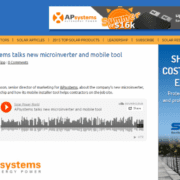

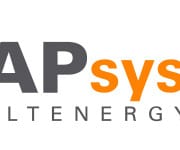

 Nelson comes to APS with over seven years in the solar industry. He most recently served as senior director of strategic accounts with UK microinverter firm Enecys, where he oversaw distribution and sales for North, Central and South America and Australia. He has also held sales directorships with SolarBridge, Uni-Solar and Ningbo Solar. His expertise includes solar microinverters and PV modules, utility grid equipment and wireless communication.
Nelson comes to APS with over seven years in the solar industry. He most recently served as senior director of strategic accounts with UK microinverter firm Enecys, where he oversaw distribution and sales for North, Central and South America and Australia. He has also held sales directorships with SolarBridge, Uni-Solar and Ningbo Solar. His expertise includes solar microinverters and PV modules, utility grid equipment and wireless communication.




 APS has reimagined the possibilities of the solar microinverter, and the national media are taking notice. Solar Builder magazine features APS Microinverters on the cover of their July/August edition with a lengthy feature story, “Rethinking Microinverters: APS America changes the game with microinverters that power multiple PV modules.”
APS has reimagined the possibilities of the solar microinverter, and the national media are taking notice. Solar Builder magazine features APS Microinverters on the cover of their July/August edition with a lengthy feature story, “Rethinking Microinverters: APS America changes the game with microinverters that power multiple PV modules.”
